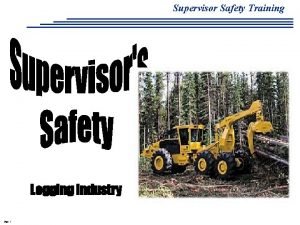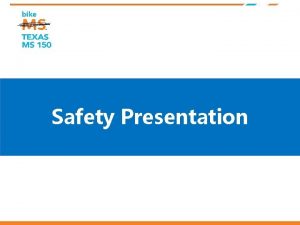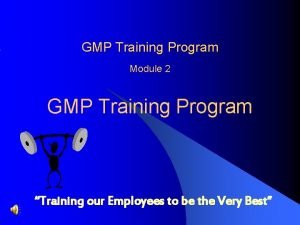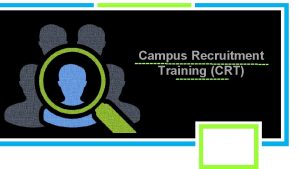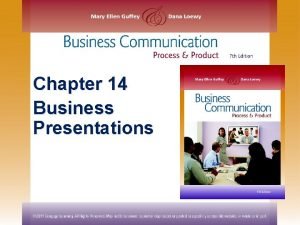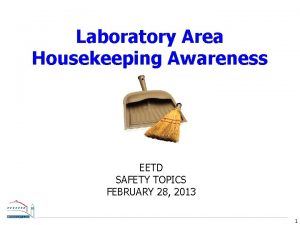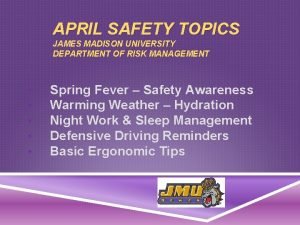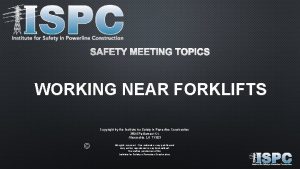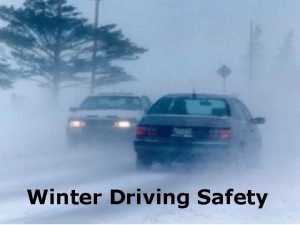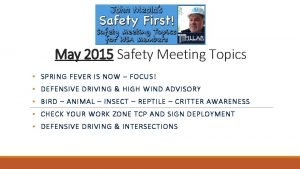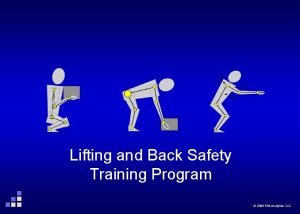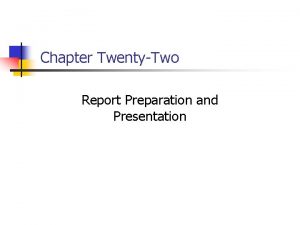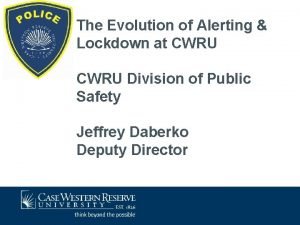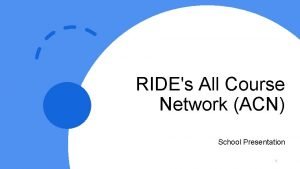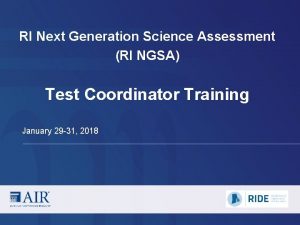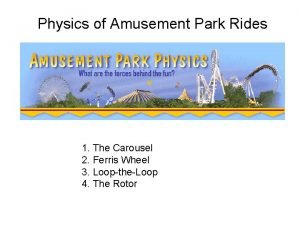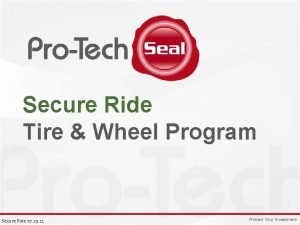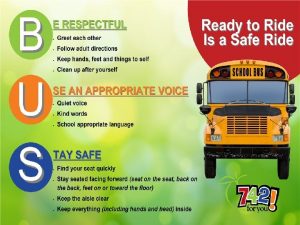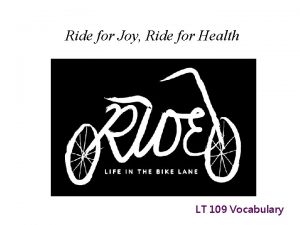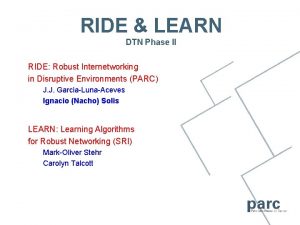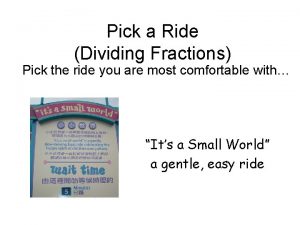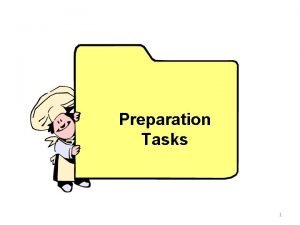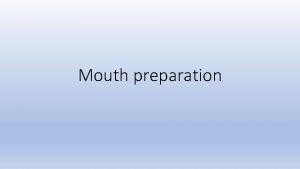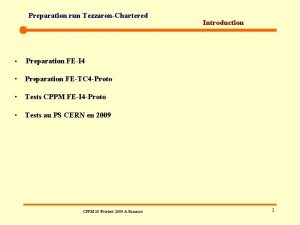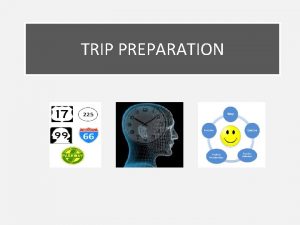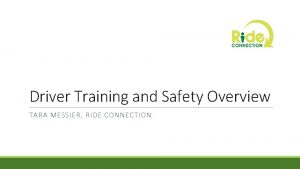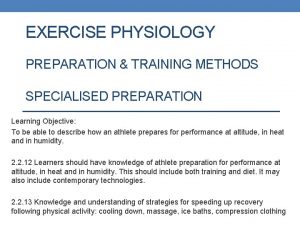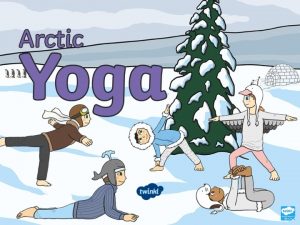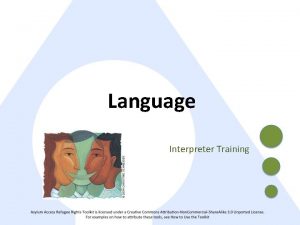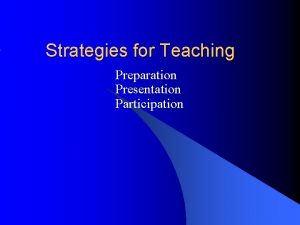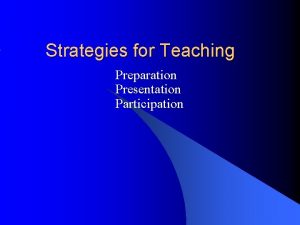Safety Presentation Presentation Topics Ride Preparation Safety Training








































- Slides: 40

Safety Presentation

Presentation Topics • • Ride Preparation Safety Training Event Weekend

Ride Preparation • • Bike Safety Inspection ABC Quick Check Cycling Equipment Cycling Clothing Helmet Fit Nutrition Hydration

Bike Safety Inspection • • • Bike Safety inspections for participants are not mandatory, but are strongly encouraged by the National MS Society to promote a safe Texas MS 150. • Bike Safety Inspections are performed by Bike Store Sponsor only. • • Once your bike passes the Safety Inspection, you will receive a Texas MS 150 Safety Inspection Sticker to display on the stem of your bike • • With this sticker you are eligible for FREE labor (parts and materials are extra) if you need any mechanical repairs during the Texas MS 150 • NO COST Bike Safety Inspections from July 27, 2020 through September 18, 2020; $15 fee from September 19 through September 25, 2020. • Visit the Texas MS 150 website for a list of Bike Stores Sponsors

ABC Quick Check To be sure you have a safe ride every time, perform the ABC Quick Check each time before heading out on your ride A is for Air • Inflate tires to the pressure listed on the side of the tire • Use a pressure gauge to ensure proper pressure • Check for damage on tire and replaced if damaged B is for Brakes • Inspect pads for wear; replace is there is less than a ¼” of pad left • Check cable tightness, frayed cables and alignment of the pads with the rims Q is for Quick release • Make sure your quick releases on your wheels are all closed Check • Check you helmet for cracks and make sure it fits properly • Check your shoes for tight cleats and straps and buckles are in good repair • Make sure you saddle (seat) is at the right height and the bolt is tight C is for Cranks, Chain and Cassette • Check you pedals and cranks for tightness • Check chain for looseness and bad links • Check derailleur for worn cogs and adjustment • Check that your gears change smoothly Image courtesy of League of American Bicyclists

Cycling Equipment • • • Bike proper sizing & fit is the MOST important thing! Helmet – NEVER ride without one! Snug fit – if pushed from front, helmet should not move Sunglasses – any type of glasses will protect eyes from flying objects, shatterproof are ideal Water Bottles (and cages to hold them mounted to bike) Or Camelbak (backpack & fanny pack styles) • H 20 and electrolyte replacement drink Cycling Shoes – “Clipless Pedal System” (allows you to push & pull your pedals) or Cages • SPD – recessed into the shoe, easier for walking, often on gym spin bikes • LOOK – protrudes from bottom of shoe; difficult to walk in, wear down & need to be replaced • Cages – attach to pedals and allow you to wear tennis shoes, more efficient than pedals alone. Floor Pump – Road bike tires should be aired up before every ride, usually about 100 psi (check tire for psi) Bike frame pump (mounted to bike frame) or Co 2 cartidiges and dispenser Under Seat Bag (Saddle bag) – to store many of the items listed in “OTHER” below Cycle Computer – tracks distance, cadence (how fast you’re pedaling) speed & various other metrics

Cycling Clothing • Cycling Shorts – chamois = padding (tip don’t wear underwear) • Try on several brands & styles, worth investing in a good pair • Cycling gloves –cushion provides shock absorption & protects hands in case of fall; fingerless for warmer weather and full finger for colder weather) • Cycling Jersey – (back pockets provide a place to stash snacks, cell phone, jacket, etc. ) • If not wearing a jersey, consider wearing a top (long enough to cover your back when reached forward on handlebars) that will wick sweat away from your body • Socks – cycle specific not needed, but moisture wicking is important (warm wool pair for cold rides) • Arm & leg warmers (easy to remove as it warms up) • Jackets – back pockets are handy and removable sleeves let you turn jacket into a vest as it warms up

Helmet Smart Select a certified Helmet (ASTM or Snell sticker) Correct Fitting of Helmet 1 1 to 2 fingers between eyebrows and rim of the helmet 2 Ensure straps are not covering the ears and form a “Y” shape below the ears 3 Chin strap snug under chin – less than ½’ (less than 1 finger width between the chin and the chin strap *Shake your head from side to side; there should only be a little movement In the event of an accident, a loose helmet won’t provide protection (the same as not wearing a helmet at all) *Replace helmet if involved in an accident or older than 3 years Head injuries are a special concern for cyclists. Even falling at a slow rate of speed can cause a serious head injury Helmets must be on your head and strapped securely while riding in the Texas MS 150 – NO exceptions. Participants found not to be wearing their helmets will be disqualified from the ride and removed from the route.

Nutrition/Hydration • • • Nutrition – Training Nutrition – Night before the Texas MS 150 Nutrition – Morning of the Texas MS 150 Nutrition – On the route Hydration

Nutrition – Training Practice nutrition when training Rides 1. 5 hours or longer should include carbohydrates Aim for 30 -60 g of carbs/hr. (120 -240 calories) Consume electrolyte sports drink and water (alternating between both) while training– test sports drink products while training to find what works best for you • Determine what works: bananas & oranges, gels, sport drink, solids, a mixture; energy bars, protein bars and power gels are an easy way to re-fuel during a ride • Remember… …There is no one perfect system for everyone! • •

Nutrition – Night Before the Texas MS 150 • Continue with normal high carb training diet while tapering exercise. Don’t go crazy carb loading • Avoid high fat, high fiber, greasy foods or anything you know will upset your stomach. • Avoid foods you are unfamiliar with • Good examples: • 1 -2 cups cooked pasta, 3 -5 oz. lean meat, fruit, fluids • 1 -2 cups cooked rice, 3 -5 oz. lean meat, fruit, fluids • 6 oz. baked potato, 3 -5 oz. lean meat, fruit, bread, fluids

Nutrition – Morning of the Texas MS 150 • Go with what works for you! (avoid untested foods) • Plan ahead, if you have special dietary needs (carry those snacks with you on the ride) find out what options are available on the ride • Eating 2 or more hours in advance? Can handle up to 1 g of carbs/lb body weight • If eating closer to start time, or need one last snack, 30 g carbs within 1 hour is ok • Examples: • 1 -2 scrambled eggs, 1 banana, toast & water/sport drink • Bagel with jelly & water/sport drink • Toast with fruit & water/sport drink

Nutrition – On the Route • At this point, should be comfortable consuming ~60 g carbs/hour • Any combination of gels, liquids, solids (energy bar and protein bars or snacks such as trail mix and fruit – bananas, oranges • Remember, sport drinks are made specifically for rapid and comfortable absorption • Aim for 20 -40 oz fluid each hour • Use your training knowledge/experience

Nutrition – Recovery • Three R’s of Recovery: • Rehydrate: With fluid and electrolytes • Consume 20 -24 oz for every lb. lost • Replenish: Glycogen (carb storage) with easily digestible carbohydrates • Chocolate Milk • Bagel with peanut butter • Yogurt with chopped fruit & honey • Yogurt/fruit/milk smoothie • Fruit Repair: Consume protein

Hydration is a primary factor in controlling body temperature and key to long distance riding Waiting till thirsty = too late! • • Have a plan (test it on training rides) How much you drink depends on the weather Monitor fluid status During training • Drink at least one bottle (approx. 16 oz) of fluid per hour while riding • Rotate between water and sports drink

Hydration Before the Ride • Proper Hydration starts several days before a ride. • You should be drinking 8 -10 glasses of water a day for at least 3 days leading up to a planned ride. • It is almost impossible to catch up during a ride. If you get behind in drinking water / sport drink, it’s difficult to consume enough water to avoid dehydration effects (loss of sweat, overheating, heat exhaustion, etc. ). • • During the ride Drink 20 -40 oz/hour of fluid Need sodium (500 -1000+mg) each hour Sodium can be found in sports drinks, electrolyte tablets, and salty snacks such as pretzels.

Hydration After the Ride • After finishing a ride of any distance, continue to drink water. • You need to first replace lost fluids from sweat and exercise. • Drinking water at the same rate of 8 -10 glasses a day for 2 -3 days after a long ride helps the body flush built up lactate acid from the muscles.

Safety • • • Texas MS 150 Safety webpages Safe Cycling Quiz Safety Information Bicycle Laws Group Riding Passing Etiquette Road Hazards Controlled Intersections Riding Safely in Hills

Safety Resources- Texas MS 150 website Resources (tab) • Safety Infographic • Bike MS Safety Brochure • Youth Riders • Heat Exhaustion Guidelines • Staying Safe at Bike MS Video Education (tab) • Safe Cycling Quiz • The Basics of Riding in a Group • Group Cycling Communications “Know the Lingo” Safety Resources • Bicycle Laws • Helmet Smart • On the Route • Group Riding • Know the Lingo - Group Riding • Passing Etiquette • Rest Stops • Controlled Intersections • Road Hazards • Tips for Riding Safely and Smart • Riding Safely in Hills • Ride Friendly • Signaling a SAG

Experience (tab) • Benefits of Training • How to Train • Injury Prevention • Learning How to Use Your Bicycle Gears Efficiently Equipment (tab) • ABC Quick Check • Bicycle Safety Inspection • Cycling Equipment • Cycling Clothing Coordinators (tab) Team Safety Coordinator • Team Safety Coordinator Information • Team Safety Presentation • Coordinator Resources Document

Safe Cycling Quiz Complete the Safe Cycling Quiz on the Texas MS 150 website to increase your knowledge of safe cycling practices in preparation for the ride. Website: Ride Logistics/Safety/Education

Bicycle Laws All states consider cyclists to be vehicle operators and give them the same privileges and responsibilities as other drivers • Know and Obey All Traffic Laws: The golden rule of bicycling in a group is "Be Predictable" • Obey All Traffic Signs and Signals: Avoid "following the leader" through traffic signs and signals; you are required to obey all traffic signs and signals, including stopping at red lights and stop signs • Look & Signal before You Move: Always scan behind you before changing lanes or making turns, and perform the appropriate, continuous arm signal prior to a turn or lane change (unless arm is needed to control the bike) and while stopped waiting to turn • Two at a Time: Ride no more than two abreast and do not impede traffic (if a part of the road has been closed and dedicated to "bicycle travel only", you may ride more than two abreast) • Hands on the Handlebars: Do not carry anything that prevents keeping your hands on the handlebars • Pass with Care: Do not pass at intersections

Group Riding • • • Ride Predictably: Just like driving a car, cyclists should ride in a smooth and consistent manner Communicate: • Communicate, in advance, by using verbal • and hand signals to fellow cyclists and • automobile traffic so they can predict • what you, the cyclist, will be doing • Verbal warning examples: approaching or passing on • your left, slowing, stopping, flat, car up, car back, etc. Awareness: • Be aware of others around you and ride with your head up. • Do not use aero-bars in a group. Image courtesy of League of American Bicyclists • Never wear listening devices on or near your ears • Do not use your cell phone while riding your bike Control: • Maintain control and speed of your bike • never overlap your wheels with another cyclist Spacing: Ride no more than 2 abreast

Group Riding – Know the Lingo Group riding has its own form of communication. Remember to pass all communication on to the cyclists behind you in the group Speak loudly and clearly • "On your left" – This means a rider is approaching your left side; move to the right (as able) to allow room for the other rider to pass • "Car back" – This means a car is approaching from the rear. All cyclists move to the right side of the road to allow the car to pass (in most states, the law requires cyclists to ride no more than two abreast, ensuring easier and safer passing of cyclists by automobile traffic) • "Gravel"/"Pothole"/"Sand"/"Tracks" – Each of these messages is to alert the cyclists behind you of hazardous road conditions, relayed not only by words but also by the gesture of pointing to the hazard well in advance • "Flat" – This indicates that a cyclist has suffered a flat tire and needs room enough to slow down and move to the right side of the road or trail for repair; offer assistance if needed • "Slowing" – The cyclist in front of you is slowing down, so use caution and prepare to stop (the common hand signal for this is to display the palm of their hand toward riders behind them to indicate slowing and stopping) • "Stopping" – This indicates that a cyclist ahead is stopping; when at a stop, do not forget to unclip from your pedals *Group communication between teams and between individual riders is vitally important to ensuring the safety of all riders. Therefore, use of headphones, cell phones, radios, or similar devices are NOT permitted while riding the Texas MS 150

Passing Etiquette Proper passing makes the ride safe for everyone Rider Passing: • Call "Approaching rider" as you get close (within 10 -20 yards) • Check the road behind to ensure no approaching vehicles • Move over to allow enough room, speed up just a little and start the pass • Call "Passing on left" as you pull near the rider • Adjust your volume for the weather - if it's calm, you don't need to shout, if it's windy, you will need to raise your voice • Allow plenty of room before moving back over to the right • Call “Thank You!” as you pass Riders being passed: • Be aware of approaching riders (listen, NO headphones!) • Acknowledge calls to pass - saying "Thank You" is a GREAT way to do this! • Maintain a steady speed and line don't suddenly slow down or speed up as you are being passed and don't jerk your handlebars.

Road Hazards Remember safety is each cyclists’ responsibility! Hazard examples: • The road surface itself with holes or cracks; • Railroad crossings/tracks – obey the signal, when clear cross tracks perpendicular • Hazards on the road such as glass, gravel or roadkill; • Unexpected issues such a dog, pedestrian or cyclist stopped on the roadway. Avoidance is key: • Look ahead when riding to identify possible obstacles or problems in your path • Plan your "escape" well in advance • Stay Right: Ride in the right portion of the rightmost lane in the direction you are traveling and leave at least four feet between your handlebars and parked cars or other cyclists Communication: • The leader or first person in a group of cyclists (with best forward visibility) should call out and identify any hazards to warn following cyclists • All other cyclists should also call out the hazard to ensure riders behind them are prepared Adjust your personal safety zone to fit the weather conditions

Controlled Intersections • • Most intersections with Stop Lights will have Law Enforcement Officers assigned to manage traffic at the intersections. IN ALL CASES – OBEY THE OFFICER’S INSTRUCTIONS When approaching a controlled intersection: First control your speed Use Hand signals and call out “Slowing” or “Stopping” Observe the intersection from a distance Are the riders stopped? Are cars present or going through the intersection? Is the officer waving cyclists through? Are there stopped cars in your lane? Be prepared to react - (slow, stop, continue) If an Officer is NOT present at an intersection: OBEY the Traffic signals (includes stop signs) RED = STOP, GREEN = GO

Riding Safely in Hills • • Hold a straight line, don’t weave and zig-zag on the hill Be Patient - Expect speed changes from cyclists on hills Be aware of limited sight by vehicles coming over the top of the hill NEVER cross the center stripe when going up a hill! Communicate and move off the road if you need to stop or walk Maintain control, speed and distance from other cyclists Control your speed going down a hill *If you need to stop and walk up the hill, call out “stopping”, signal and move to the right side of the road. Dismount and walk your bicycle staying to far right side of the lane as possible

Training • Training. Peaks Training Plan • Zwift and Strava Club • Bike MS Cyclists, Local Bike Shop Training Rides, Team Training Rides

Training Options Training. Peaks Plan • Access the Training. Peaks Plan (Training Tips & Tools on Texas MS 150 website) • Start Your Training. Peaks Training Plan by selecting one of these options: • Online Training Plan • i. Phone App • Android App • Compatible GPS App • You will receive: • A personal training calendar powered by Training. Peaks. • Log workouts and analyze heart rate, power, pace and other data. • Receive optional daily workout notifications via e-mail. • Upload your workouts from over 90 compatible devices. • View workouts on the go with free apps for i. Phone or Android. • Training Resources and advice from Training. Peaks.

Training Options Zwift While Bike MS is not connected officially with Zwift we highly recommend you check it out for a great virtual training experience. Strava • Bike MS created a Strava Club you can connect with other Bike MS riders. Share your riding activities and connect with riders from all over country. • A great way to learn about other Bike MS events and cultivate an amazing online experience with like-minded riders. • You can find the club in Strava by searching under clubs for “Bike MS Cyclists” or by visiting: https: //www. strava. com/clubs/Bike_MS

Training Options Local Bike Shop rides • Check in with local bike shops in your area to see if they offer weekly training rides that you can join. Team Training Rides • Part of team - ask if they have weekly or monthly rides to join. Not a part of a team? Reach out to us and we can get you connected with a team looking to take on rookie riders and would be a good fit for you. Other training options • Spin bike, exercise bike or bike trainer • Interval training to build up cardiovascular system and increase endurance

Day of Event • • Tips for riding smart and safe On the Route Rest Stops Route Support Ride Marshals SAG Support Ride Friendly

Tips for Riding Smart and Safe • Texas MS 150 is a RIDE, NOT A RACE! • Expect crowded conditions at the Start, Route Merge Points, Rest Stops, Lunch Stops, and the Finish. • Vehicle Traffic – The roads we use are not closed! Keep as much distance between you and the automobile traffic as possible. Use courtesy and etiquette when interacting with vehicles. • Keep to the right unless passing. Pass on the left. Call out “Passing on Left. ” DO NOT PASS ON THE RIGHT • Communicate verbally and using hand gestures (slowing, stopping, obstacles, etc. ) • DO NOT CROSS the yellow center line. • Ride with no more than two (2) abreast • Be Courteous, Be Patient and Ride Friendly

On the Route • • Do not overlap wheels with the cyclist in front of you Control your speed. The ride will be slow at first until the cyclists spread out on the route (slow again at route merge points) Pay attention to cyclists around you (have an escape plan) Hydrate – Drink at least 1 water bottle between rest stop Nutrition – Eat snacks about every 15 -20 miles (use what you learned on training rides) Ride your pace. Don’t try to go faster than you’re comfortable Stop and take a break if you’re tired. Pull all the way off the road to stop Obey ALL Traffic Laws

Rest Stops Breakpoints are points of high cyclist congestion Use caution when entering and exiting a rest stop Entering: • Stay to the right or left of the lane depending on the placement of • the rest stop on the right or left side of the roadway • Announce you are stopping and then move quickly and completely • into the rest stop. • Communicate with hand signals and callout your intentions • If stopping, ride ALL THE WAY INTO THE REST STOP before stopping DO NOT STOP IN THE ROADWAY! • If you are not stopping at a rest stop, slow down then stay on the appropriate side of the lane to avoid those who are entering/exiting the rest stop. Exiting: • • When exiting a rest stop do so from the down route side of the rest stop. Watch for oncoming cyclists or traffic, and slowly and safely merge back into the ride. DO NOT STAGE IN ROADWAY AND THEN PREPARE TO START! Be ready to ride once you move out of the rest stop.

Route Support Ride Marshals are registered riders who act as Good Will and Safety Ambassadors for the Texas MS 150 and the Recommended Rides. Bike Police are volunteer riders and certified law enforcement officers who serves along the route implementing safety protocol and directing traffic when needed. Bike Medics are volunteer riders and licensed medical care providers who provide basic medical assistance along the route until advanced medical care arrives. Motorcycle Marshals patrol the route to assist with cycling traffic and respond to emergencies and traffic situations. SAG (Support Vehicles) Special Assistance Group (SAG) vehicles provide transportation to riders who need a lift to the next rest stop. SAGs do not stop to make bike repairs, but they will bring riders to the next rest stop. SAGs only move a rider forward along the route. To signal a SAG vehicle driver follow these steps: 1. Move safely off the road and well out of the path of other riders 2. Dismount and stand near your bike 3. Remove your helmet and wave it at the SAG vehicle Medical Support Team Certified medical professionals (EMTs, paramedics and nurses) who administer first aid and who are trained in CPR. They assist along the route, at rest stop, lunch sites, overnight sites and at the finish line.

Day of Event: Ride Marshals • • Ride Marshals are volunteers who help keep the ride SAFE Be courteous and obey instructions from Ride Marshals provide coaching on how to to ride safe and coach you if they observe you doing something unsafe Ride Marshals have authority to notify National MS Society staff if unsafe riding continues. National MS Society staff may remove a rider from the route if necessary. National MS Society staff will notify Team Captains of unsafe riders Ride Marshals are happy to stop and assist riders with minor problems (flat tire, mechanical, etc. ). Let a passing Ride Marshal know if you need assistance.

Day of Event: SAG (Special Assistance Group) • Special Assistance Group (SAG) vehicles provide transportation to riders who need a ride to the next rest stop. • SAG vehicles do not make bike repairs • SAG vehicles only move a rider forward along the route. To signal a SAG vehicle driver follow these steps: • Move safely off the road and well out of the path of other riders • Dismount and stand near your bike • Remove your helmet and wave it at the SAG vehicle

Ride Friendly • • Obey law enforcement personnel and ride officials Don’t litter! Obey all State & Local Traffic Laws Support the Local Communities Respect Private Property Use Provided Restroom Facilities ONLY Curb Inappropriate Language & Profanity
 Funny enthymeme examples
Funny enthymeme examples Safety images
Safety images Safety presentation topics
Safety presentation topics Safety care training
Safety care training Behavioural training topics
Behavioural training topics Defence infrastructure panel
Defence infrastructure panel Gmp training program
Gmp training program Gad laws and mandates
Gad laws and mandates Crt aptitude
Crt aptitude Sociolinguistics topics for presentation
Sociolinguistics topics for presentation Wildlife topics for presentation
Wildlife topics for presentation Science topics for presentation
Science topics for presentation Ib iop
Ib iop Botany topics for presentation
Botany topics for presentation Embedded systems topics for presentation
Embedded systems topics for presentation Legal topics for presentation
Legal topics for presentation Classical view of social responsibility
Classical view of social responsibility Presentation in hindi topic
Presentation in hindi topic Overview of microprocessor
Overview of microprocessor Oop presentation topics
Oop presentation topics Nuclear physics topics for presentation
Nuclear physics topics for presentation Multimedia presentation topics
Multimedia presentation topics Housekeeping in laboratory
Housekeeping in laboratory Hand tool safety toolbox talk
Hand tool safety toolbox talk April safety topics
April safety topics August safety topics
August safety topics Forklift safety meeting topics
Forklift safety meeting topics Winter driving safety topics
Winter driving safety topics Safety topics for spring
Safety topics for spring Back safety training
Back safety training Report preparation and presentation
Report preparation and presentation Report preparation and presentation in marketing research
Report preparation and presentation in marketing research Cwru safe ride
Cwru safe ride Sweep in the past
Sweep in the past Ride acn
Ride acn Rhode island next generation science assessment
Rhode island next generation science assessment Ride teacher evaluation rubric
Ride teacher evaluation rubric Free verse poem kids
Free verse poem kids The rotor amusement park ride
The rotor amusement park ride One fish two fish red fish blue fish ride
One fish two fish red fish blue fish ride Logisticare san antonio
Logisticare san antonio

